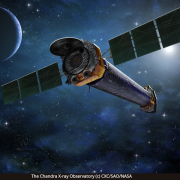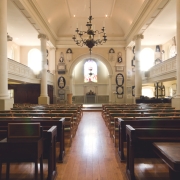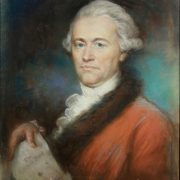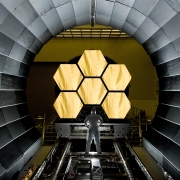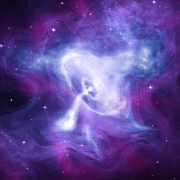Image credit: (c)
This event is part of H200 – the Herschel Society’s celebration of William Herschel on the bicentenary of his death.
A joint conference put together by the Herschel Society in tandem with Bath Royal Literary and Scientific Institution, and being held at Queen Square in Bath, is the centrepiece of the Herschel Society’s celebration of William Herschel’s achievements on the 200th anniversary of his death in 1822.
If you love astronomy, but Herschel’s home city of Bath feels light years away, you might be pleased to know that you can attend the conference both live at Queen Square and online. Wherever you are in the world you will be able to engage in the company of likeminded enthusiasts.
Why is it that we celebrate Herschel over 200 years after his death? William Herschel’s discovery of the planet Uranus in 1781 brought him widespread fame, but his importance to astronomy rests much more on his pioneering work on the deep sky beyond our solar system over the subsequent decades.
This fantastic day of talks will bring the chance to explore William’s telescope making; observing methods; ground- breaking deductions; unique collaboration with Caroline his sister, in cataloguing the deep sky; his speculative views on life on other worlds. The conference will show what this has led to today in the latest astronomical survey work by the Gaia space observatory. It will also illustrate his achievements in other more surprising ways.
The conference delivers the chance to engage with Herschel’s work at a far deeper level and each talk allows for questions with the visiting speaker. There will also be the chance to talk among yourselves and share thoughts with likeminded friends.
Was William Herschel the greatest astronomer the world has ever known? Charles Draper shares with us just some of the reasons we celebrate Herschel over two hundred years after his death. To know more about Herschel and the breadth of his achievements don’t forget to book your tickets for our conference on October 1st.
Watch Charles Draper now.
Schedule for the day.
9.30 – Welcome and Introduction (Charles Draper, Chairman, Herschel Society)
9.45 – The Context of William’s Life and Work (Professor Mike Edmunds, President of the Royal Astronomical Society)
10.00 – William’s Telescopes (Dr Jim Bennett, Keeper Emeritus of the Science Museum, London) William built the finest deep sky telescopes in the world in the late Eighteenth century, but just how he prepared and finished the reflecting surfaces of these astonishing instruments is less well understood.
10.45 – Coffee
11.00 – William Herschel’s Astronomy (Dr Wolfgang Steinicke, author of William Herschel – Discoverer of the Deep Sky). William and Caroline catalogued 2500 deep sky objects, and William deduced many important characteristics of them and our galaxy as a result. Their results and methods were key pioneering works of modern astronomy.
12.00 – William and Caroline in their own words (Dr Sian Prosser, Librarian and Archivist at the Royal Astronomical Society) William and Caroline have left us fascinating records of their work, including annotations on an earlier star atlas and revealingly different accounts of important events.
12.45 – Lunch Interval (self-organised). Demonstrations by Dr Bob Fosbury (ex European Space Agency astrophysicist and current UCL researcher on vision) on Infra-Red Radiation and Bath Spa University Students of their 3D virtual model of William’s finest telescope.
13.45 – William and Georgian views on extra-terrestrial life (Dr Josh Nall, Curator at the Whipple Museum of the History of Science, University of Cambridge) William strongly believed in the presence of life on heavenly bodies – even the sun. This was not unusual in his time.
14.30 – Giant Strides from Herschel to Gaia; Mapping the Sky from Space (Dr Michael Perryman, Ex Space Scientist with the European Space Agency, including key leadership roles on the Gaia Mission) Tracing the steps of how comprehensive surveys of the sky are revolutionising our understanding of the universe as they did in the Herschel’s’ time.
15.30 – Coffee
15.45 – Round Table Discussion
16.45 – Closing remarks by Dr Allan Chapman (President of the Herschel Society)
17.00 – Closing drinks for those at BRLSI
17.45 – End
JOIN US FOR ‘A CELEBRATION OF THE ASTRONOMY OF WILLIAM HERSCHEL’ , SATURDAY 1ST OCT 2022
Video recordings of the following lectures from the conference are now freely available on YouTube – use the links below.
Part 1
Introduction (Charles Draper)
The Context of William’s Life and Work (Professor Mike Edmunds)
William’s Telescopes (Dr Jim Bennett)
Part 2
William Herschel’s Astronomy (Dr Wolfgang Steinicke)
Lunchtime demonstrations (Dr Bob Fosbury and Bath Spa University students)
Part 3
William and Georgian views on extra-terrestrial life (Dr Josh Nall)
Round Table Discussion
Closing remarks (Dr Allan Chapman, Charles Draper)
Virtual Telescope
Bath Spa Students 3D Virtual Model of Herschel’s 20 ft telescope – you can see the virtual model in a website created by the students here:
https://herschel200.com/


